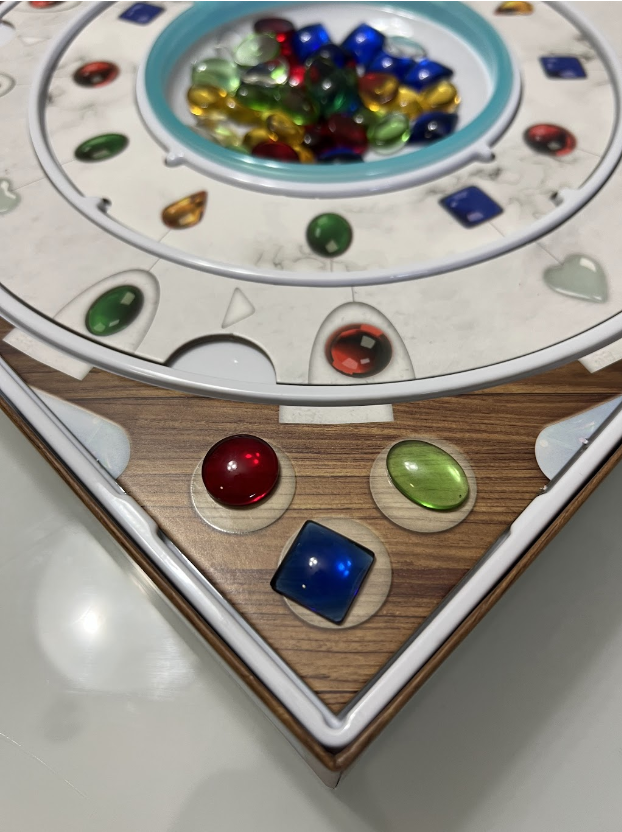Mission: Review - Murano: Light Masters
Glassmaking has been a staple of society for thousands of years. Where it originally began has been debated, but it is believed to have started in Egypt or Mesopotamia. Murano, a series of islands north of Venice, Italy, became famous for its glass making during the 13th century. Today, Murano’s glass is still considered some of the best in the world. In Murano: Light Masters, you play as a Venetian glassmaker, collecting glass pieces and creating beautiful works of art. Does Murano: Light Masters live up to this reputation? Let’s take a deeper look into the game and find out.
On your turn, you will go through two phases. First, you must rotate the selector ring one notch clockwise. Then, you must take the two glass shards the selector is pointing towards from the supply; however, you can never have more than eight shards. Second, you must negotiate or exchange shards on your workbench. You have three options available to trade in shards:
Option number one: Add one of your shards to an available space in one of the markets in the four corners of the board. If you do this, you will get two or three shards, depending on what is currently connected to the market.
Option number two: You may spend lira to buy all the shards in any one of the four markets, which will get you one to three shards.
Option number three: You may sell any number of your shards for one lira.
After collecting and exchanging are complete, you may complete the top creation card in your hand. At the beginning of the game, you are dealt five of these creation cards, but you are not allowed to change the order of the cards once they are in your hand. Additionally, the creations show four glass shards that you must have to complete the card. If you decide to complete a creation card, you remove the four shards shown on the card from your workbench. Then, you gain a number of lira equal to the number of empty spaces on your workbench. If you are able to complete two cards in one turn, you gain an additional two lira.
At any point during your turn, you may also perform three bonus actions as many times as you would like. These actions allow you to change the order of the creation cards in your hand, rotate the outer ring of the board to change the position of the shards, or activate an advantage card by spending a completed creation card with a matching symbol.
When someone has completed all of their creation cards, each player is allowed one more turn and the game ends. Once everyone has had a final turn, everyone counts up their lira and whoever has the most lira is the winner!
If you got overwhelmed or confused reading that, I don’t blame you. It took me nearly half of my first game to really get a grip on all the options available to me on a single turn. The number of options and how best to utilize each option really takes some thought. The strategy of the game, and really utilizing these choices, starts to shine during the second or third game. One option you have on your turn is to use a completed creation card to use an advantage. There are many different advantages, and you will only use four per game. The advantages are essentially a bonus action you can do. This adds a some amount of variability and replayability. I did like that the creation cards have this secondary use, but the advantage cards have unclear symbology and you have to refer to the rulebook every time someone wants to use one.
Murano: Light Masters is classified as “abstract”, a genre that includes a wide variety of games. Abstract games are typically theme-less, easy to teach but hard to master, and generally have little to no luck involved. Murano: Light Masters could truly have any theme and nothing about it would change. Is this a bad thing? I don’t think so. The theme is unique and helps it stand out amongst the myriad of other abstract games. The theme also allows for the game to have some truly lovely components; the glass shards are beautiful, and so are the creations. In my eyes, this theme is a plus for the game.
My biggest issue is that I found the game to be too easy, and so did other people I played with. But we also have experience playing more difficult games. However, there are other games at this level of difficulty that I truly love playing. With that in mind, though, I don’t see this as a bad game at all. I did enjoy my time with it, but I think I have gotten all I can out of this game. I would recommend this game for people who are new to board gaming and are intrigued by the theme. If that is you, then I say go for it!
Likes:
Theme is fun and unique
Easy to learn and teach
Quick turns and fast playtime
Dislikes:
Too easy
Low replayability
If this sounds like a game that would be fun for you, head on over to any of our two Mission: Board Games locations or order a copy online here.
About the author: Will Purdy is an avid board game enthusiast and barista at Urban Prairie Coffee in Mission, KS. Follow him on instagram @ instagram.com/boardgamebarista or on Board Game Geek: fidgetyrain


